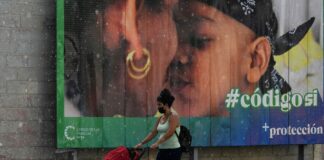The misguided assumption that rural America is hopelessly backward and bigoted erases centuries of same-sex relationships in rural communities. It tells young queer people that they must flee their rural hometowns to far-flung cities in order to find safety and acceptance.
That’s why we see so much value in the work of photographer Luke Gilford. For “National Anthem,” his collection of images on display at Manhattan’s SN37 Gallery, Gilford photographed participants in the International Gay Rodeo Association. Many of his subjects have fought for decades to be seen as legitimate riders in the rodeo world, bringing their rural sensibilities and queerness to arenas across the country.
As scholars of gender, sexuality and the American West, we’ve spent years studying gay rodeoers. Through the Gay Rodeo Oral History Project and other research, we’ve been able to highlight the experiences of Gilford’s subjects and reveal the complexities of rural America.
We know that queer people have always belonged in rural places and have always participated in rural traditions. And we hope that the unashamed presentation of queer, rural rodeoers refutes the lazy dichotomy of the urban queer progressive versus the rural homophobic conservative.
The fantasy of the straight, white cowboy
The cowboy has long stood as a symbol of American values and virile masculinity. But this understanding of the cowboy hides a more complex reality.
Cowboys were once the outcasts of Victorian American society. They tended to be poor nomads, and ranch work and cattle drives attracted a racially diverse workforce, including Black, Hispanic, Indigenous and Chinese residents of the American West.
As the frontier way of life faded in the late 19th century, a nostalgia for cowboys soon emerged in American culture. Artists like Frederic Remington and entertainers like Buffalo Bill Cody glorified them through their art and Wild West shows.
By the 1950s and 1960s, movie Westerns featured actors like John Wayne and Clint Eastwood. Nearly all of these depictions portrayed the cowboy as white, straight and male. Black and Indigenous cowboys, as well as women riders, gradually disappeared from the national imagination.
The origins of gay rodeo
The symbolism and iconography surrounding cowboys matters a great deal. In the 20th century, the American West became intimately associated with a national American identity. The image of the cowboy, if he looked and acted a certain way, determined who could and couldn’t be a “real” American.
Yet many queer people living in rural areas in the 1970s and 1980s refused to relinquish their claim to a rural – and an American – identity.
They were inspired, in a way, by the emergence of the urban cowboy phenomenon in fashion, film and country music. The cowboy was just one of the models of desirable masculinity that emerged in the post-World War II era for gay men. Urban gay bars adopted country-western motifs, attracting a clientele of urban “wannabe” cowboys and rural transplants looking for a community that reminded them of home. Soon, there was a real enthusiasm and appetite among queer people for a rodeo of their own.
Phil Ragsdale, a businessman from Reno, Nevada, organized the first gay rodeo in 1976 as a fundraiser, with proceeds benefiting the local senior center and the Muscular Dystrophy Association. The National Reno Gay Rodeo took place annually from 1976 until 1985, drawing tens of thousands of spectators. In 1985, the International Gay Rodeo Association formed, bringing together other gay rodeo associations, standardizing rules and creating a formal circuit for participants.
Rural queer folk went on to create other spaces that could exist beyond the imagined restraints of rural and urban life: gay country-western bars, square dances and clogging groups.
Though not all gay rodeoers come from rural backgrounds, many do. They often describe leaving their own small towns and rural communities for queer life in the city. Rather than encountering a comforting sanctuary, some found it difficult to fit in.
In an interview for the Gay Rodeo Oral History Project, gay rider Joe Rodriguez described the discomfort he felt upon moving to San Fransisco: “It was day and night coming from a rural community where I grew up, moving to the city, but it still wasn’t right, wasn’t the right fit.”
He didn’t feel at home in the city until he found a community with other queer cowboys.
The space between
Homophobes tended to condemn gay rodeo as an attack on the cowboy’s traditional place in American culture. Gay men were thought to be too effeminate and too weak to don the same getup as John Wayne.
Opposition intensified with the AIDS epidemic, along with the rise of an emboldened political and religious right. Four years after the first gay rodeo, America elected Ronald Reagan, a stalwart conservative who played cowboys on the silver screen, as its 40th president.
Gay rodeoers struggled to withstand the tide of discrimination and tragedy.
As gay rodeoers worked tirelessly to raise money for charity, some non-LGBTQ organizations started refusing to accept donations from rodeos affiliated with the International Gay Rodeo Association.
Death and loss became a fact of life.
“I had a lot of friends,” recalled a rodeoer named Brian Helander, “and I can say that of probably 100 people that I would call friends, probably three of those survived.”
Yet as self-proclaimed “queer cowfolx,” they continued to occupy spaces they were told they had no right to, and they filled their rodeo arenas with same-sex dances, camp rodeo events and drag entertainers to raise money for AIDS and other LGBTQ organizations. In creating a space that allowed for overlapping – and sometimes conflicting – identities, gay rodeoers have upended some of the long-held understandings of queerness.
Above all, they’ve made it their mission to rupture ossified notions about who has the right to lay claim to the identity of cowboy – and, by extension, American.![]()
This article is republished from The Conversation under a Creative Commons license. Read the original article.






